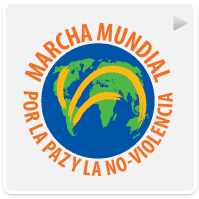The Invisibles against US missile defense
What is active non-violence?
Non-violence generally refers to some or all of the following: a system of moral concepts that disavows violence; the mass movement led by Mahatma Gandhi in India in the first part of the twentieth century; the struggle for civil rights by African-Americans in the United States under the leadership of Martin Luther King; and the activities carried out by Kwame Nkrumah in Ghana. The activities of Aleksandr Solzhenitsyn, Andrei Sakharov, S. Kovalev, and other famous dissidents opposed to Soviet totalitarianism are often included as well.
The idea of non-violence is expounded in the Bible and the writings of other religions in the exhortation not to kill. This idea has been developed by numerous thinkers and philosophers; Russian authors Leo Tolstoy and Fyodor Dostoevsky expressed it in profound formulations. Tolstoy's formula proclaiming the supremacy of love and the “non-use of violence against evil,” or better, the impossibility of fighting one evil with another, found worldwide resonance, inspiring a somewhat singular sect of “Tolstoyists.”
The non-violence movement developed by Gandhi prepared the ground for Great Britain to renounce its supremacy in India, though Gandhi himself was killed by a paid assassin.
Also M.L.King's struggle ended without victory. He was assassinated in the balcony of his hotel in Memphis, while assisting a protest which denounced the low salaries of the black people who collected the trash.
Nonetheless, the concept of non-violence , including non-violent forms of protest, continues to be a vital, evolving force in the world. Daily mass actions by lower strata of workers, meetings and protest demonstrations, strikes, women's and student movements, farmworker and peasant demonstrations, leaflets, neighborhood newspapers and periodicals, appearances on radio and TV, all these constitute the contemporary forms of the ethic and practice of non-violence.
New Humanism, developed by Silo since 1960s until today, strives to reduce violence to the greatest extent possible, to create perspectives which go completely beyond violence , and to use all possible methods and forms of bringing resolution to conflicts and dichotomies alon g the path of creative non-violence.
Non-violence is frequently equated with pacifism , when in reality the latter is neither a method of action nor a style of life but rather a sustained protest against war and the arms race.
From the above it follows that non-violence and active non-violence (1) consist of a personal commitment, a style of life and a methodology for social change.
The two pillars of the methodology of active nonviolence are civil disobedience and non-participation.
Civil disobedience has the following ideological and philosophical justification: If the State imposes laws which are violently unjust, discriminatory, etc. and the application of such laws affects people negatively because it transforms people into agents or receivers of injustice or discrimination, then people have the right and the moral obligation to not comply with such laws. Civil disobedience and non-cooperation intentionally break the unjust law and accept the punishments, for example imprisonment, as a dignified consequence of their actions.
Non-participation or vacuum towards violence implies avoiding involvement in violent situations – which usually has a negati ve economic effect to the transmitter of violence – proclaiming publicly the moral posture of both parties.
In the cases of Gandhi and M.L.King, the interest was in changing unjust laws or social realities, and only when the searched for steps could not be achieved through negotiations and persuasion, direct action with planned activities was used. (Examples of Gandhi, Salt Law and Salt March; Martin Luther King, state laws of racial segregation, bus boycott, sit-ins, marches, etc.).
We can see that these predecessors of active non-violence, and many others, were people who also had a strong and vital spiritual and religious feeling. This shows that historical moments of great changes have been accompanied by new feelings of religiosity. They are moments of hope. In such moments a great moral force is put into motion and the human landscape changes.
(1) ACTIVE NON-VIOLENCE: The strategy for struggle of New Humanism, which consists of the systematic denunciation of all the forms of violence exercised by the System. Also, a tactic for struggle applied in specific situations in which discrimination of any type is occurring.
« back









